what are slugs in WordPress? The portion of the web page address that comes after the domain name is referred to as the “slug” in WordPress. If you read a blog post at www.example.com/blog-post, “www.example.com” would be the domain name, and “blog-post” would be the post slug. This is a straightforward example of a WordPress slug.
Any post you publish by default will have the same title as the slug, but in lowercase and with dashes in place of spaces. The default post slug, for instance, would be “my-first-blog-post” if you started a blog and wrote a post with the title “My First Blog Post.”
Before publishing, you can easily edit the slug; after publishing, you can even change the default slug.
Why would you want your post slug to be personalized? Slugs, then, assist in clearly identifying a page on a website. They can aid users and search engines in determining the content of a page. Customizing your slugs can enhance your website’s user experience and SEO rankings.

Table of Contents
what are slugs in WordPress?
WordPress slugs are used to make user-friendly URLs that make it easier for users and search engines to understand what your content is about.
Consider naming a file on your computer as an analogous process. The contents of a file named “2020-family-photo.jpg” are apparent when you see it. Having a name like “IMG3256.jpg” makes things considerably more difficult.
When a post title is lengthy or the content will be often updated, editing slugs is helpful. Use the slug “July-2020-deals” instead if you won’t be updating that post with fresh bargains each month.
The URL of your postings may be visible to users on search results pages, in emails, on social media, or in other places. For instance, this is the slug for our article on how to build a WordPress blog:
Your slug might influence people’s decisions about whether or not to click the link. By making your slugs as transparent as possible, you can let visitors know what to expect when they click a link.
Your slug might influence people’s decisions about whether or not to click the link. By making your slugs as transparent as possible, you can let visitors know what to expect when they click a link.
WordPress Slug vs. Permalink: What’s the Difference?
The permanent URLs of your website’s posts and pages are known as permalinks in WordPress. For instance, this page’s permalink is https://www.wehavedigitaltool.com/glossary/post-slug/ as you read it.
The final component of the permalink is the slug.
The slug for this page would be “post-slug”.
How to Change a Slug in WordPress
By default, the post title will serve as your post’s slug. The post slug will always be lowercase, and hyphens will replace any spaces.
By selecting Settings » Permalinks from your WordPress admin sidebar, you may change the default slug.
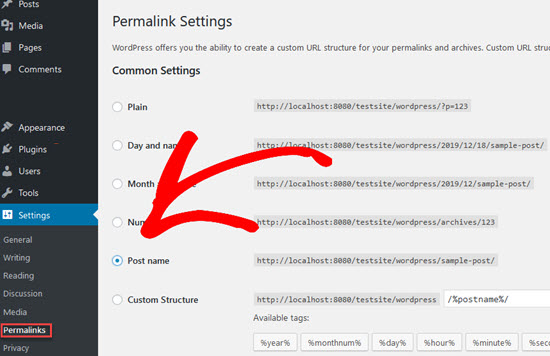
In WordPress, you may easily change the slug while updating a post or page. After entering a title for your post and clicking the Save Draught button at the top of the page when creating a new post, you’ll notice the permalink.
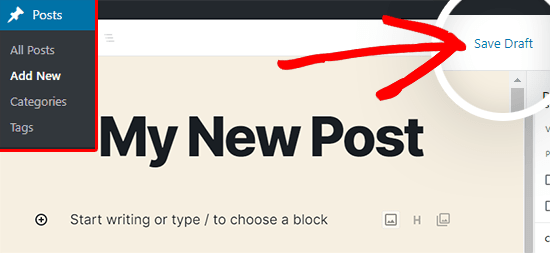
By clicking the post title and then Edit at the end of the permalink after saving the text, you may change your slug.
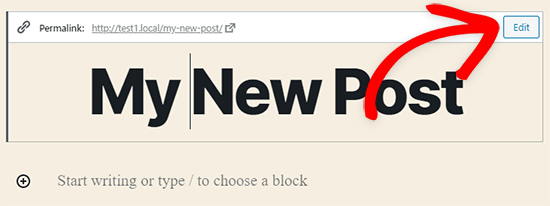
Then, after adding your unique slug to the URL’s final blank space, click the Save button.

You may easily modify a post’s slug by selecting Posts > All Posts from your admin sidebar.
Simply hover the mouse pointer over the post you wish to edit. Next, click the Quick Edit icon located immediately beneath a post.
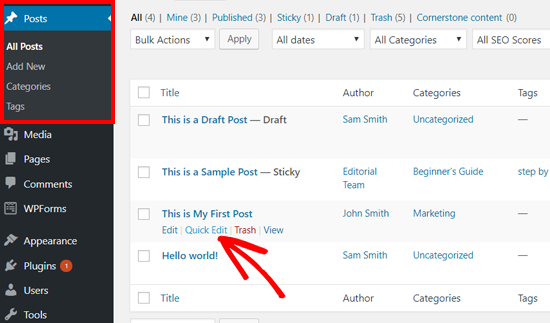
By doing so, the fast editor is opened, allowing you to modify the post slug and other settings. After making your desired modifications to your slug, simply click Update.
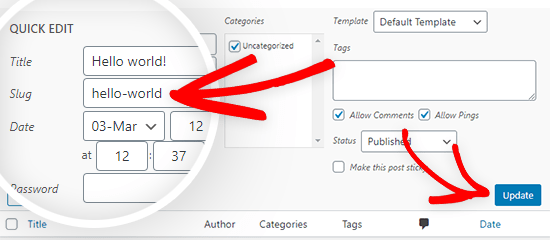
How to Change Category and Tag Slugs
WordPress creates slugs for your categories and tags automatically, but you may also develop your own. Go to the admin sidebar and choose Posts » Categories to modify a category’s name.
Click the Edit button after choosing the category slug you want to modify. As with the post slug above, enter your new slug now and click Update to save the change.
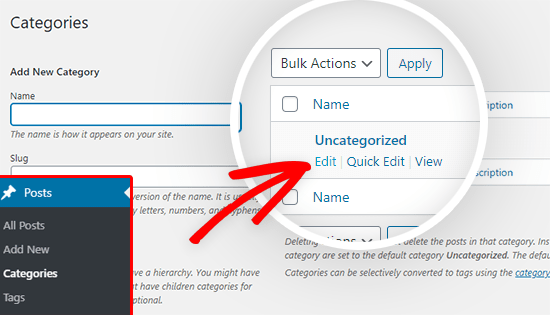
Go to your admin sidebar and select Posts » Tags to modify your WordPress tags. You may then proceed in the same manner as we did for categories from there.
How to Change the Author Slug
You can designate a unique slug for each author if your WordPress website has several contributors. By default, WordPress does not let you change the author slug.
You’ll need to utilize a plugin in WordPress if you need to update the author slug. For additional information, go to our tutorial on how to modify the author URL slug in WordPress.
How to Write an SEO-Friendly Slug
One of the things that search engines use when determining how to rank a page in search results and what content it contains is the URL of the web page.
Every time you publish a new post, you should think about writing SEO-friendly slugs if you want your website content to rank higher in search results and attract more traffic.
When releasing a new post or page, bear the following SEO advice in mind:
Avoid using dates in your slug. By doing this, you may prevent your content from appearing stale on your website, in search results, and elsewhere.
Decide on your slug before you publish. After a post has been published, you might want to modify the slug, however, this will also change the URL. Keep in mind that these are permalinks, or permanent links, to certain entries.
Your visitors and search engines won’t be able to find your material if they go to the previous permalink if you update a slug. We advise using a redirection plugin to set up redirects to your posts’ URLs to correct them.
Keep your slugs short and descriptive. Make sure the slug contains the primary term you want to rank for. Use words to describe the information in your message.
Use AIOSEO – All in One WordPress SEO plugin further to optimize your website for higher search engine rankings.
We sincerely hope that this article has given you a thorough understanding of WordPress post slugs and how they operate. To learn more, see the recommended reading list below.
Make sure the slug contains the primary term you want to rank for. Use words to describe the information in your message.
Use AIOSEO – All in One WordPress SEO plugin further to optimize your website for higher search engine rankings.
We sincerely hope that this article has given you a thorough understanding of WordPress post slugs and how they operate. To learn more, see the recommended reading list below.

